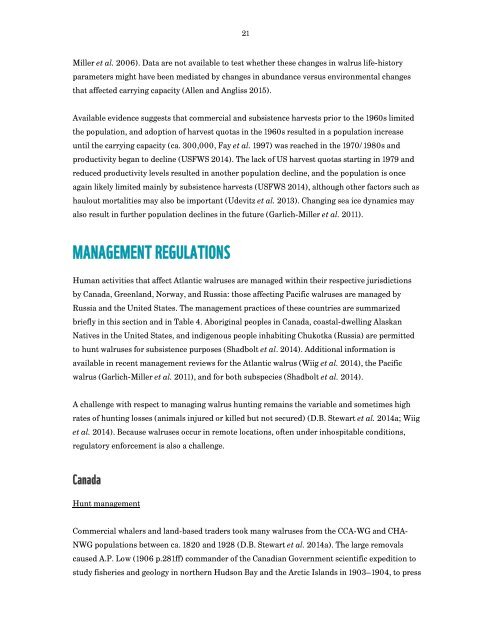The State of Circumpolar Walrus Populations
walrusreport
walrusreport
Create successful ePaper yourself
Turn your PDF publications into a flip-book with our unique Google optimized e-Paper software.
21<br />
Miller et al. 2006). Data are not available to test whether these changes in walrus life-history<br />
parameters might have been mediated by changes in abundance versus environmental changes<br />
that affected carrying capacity (Allen and Angliss 2015).<br />
Available evidence suggests that commercial and subsistence harvests prior to the 1960s limited<br />
the population, and adoption <strong>of</strong> harvest quotas in the 1960s resulted in a population increase<br />
until the carrying capacity (ca. 300,000, Fay et al. 1997) was reached in the 1970/1980s and<br />
productivity began to decline (USFWS 2014). <strong>The</strong> lack <strong>of</strong> US harvest quotas starting in 1979 and<br />
reduced productivity levels resulted in another population decline, and the population is once<br />
again likely limited mainly by subsistence harvests (USFWS 2014), although other factors such as<br />
haulout mortalities may also be important (Udevitz et al. 2013). Changing sea ice dynamics may<br />
also result in further population declines in the future (Garlich-Miller et al. 2011).<br />
MANAGEMENT REGULATIONS<br />
Human activities that affect Atlantic walruses are managed within their respective jurisdictions<br />
by Canada, Greenland, Norway, and Russia: those affecting Pacific walruses are managed by<br />
Russia and the United <strong>State</strong>s. <strong>The</strong> management practices <strong>of</strong> these countries are summarized<br />
briefly in this section and in Table 4. Aboriginal peoples in Canada, coastal-dwelling Alaskan<br />
Natives in the United <strong>State</strong>s, and indigenous people inhabiting Chukotka (Russia) are permitted<br />
to hunt walruses for subsistence purposes (Shadbolt et al. 2014). Additional information is<br />
available in recent management reviews for the Atlantic walrus (Wiig et al. 2014), the Pacific<br />
walrus (Garlich-Miller et al. 2011), and for both subspecies (Shadbolt et al. 2014).<br />
A challenge with respect to managing walrus hunting remains the variable and sometimes high<br />
rates <strong>of</strong> hunting losses (animals injured or killed but not secured) (D.B. Stewart et al. 2014a; Wiig<br />
et al. 2014). Because walruses occur in remote locations, <strong>of</strong>ten under inhospitable conditions,<br />
regulatory enforcement is also a challenge.<br />
Canada<br />
Hunt management<br />
Commercial whalers and land-based traders took many walruses from the CCA-WG and CHA-<br />
NWG populations between ca. 1820 and 1928 (D.B. Stewart et al. 2014a). <strong>The</strong> large removals<br />
caused A.P. Low (1906 p.281ff) commander <strong>of</strong> the Canadian Government scientific expedition to<br />
study fisheries and geology in northern Hudson Bay and the Arctic Islands in 1903–1904, to press


